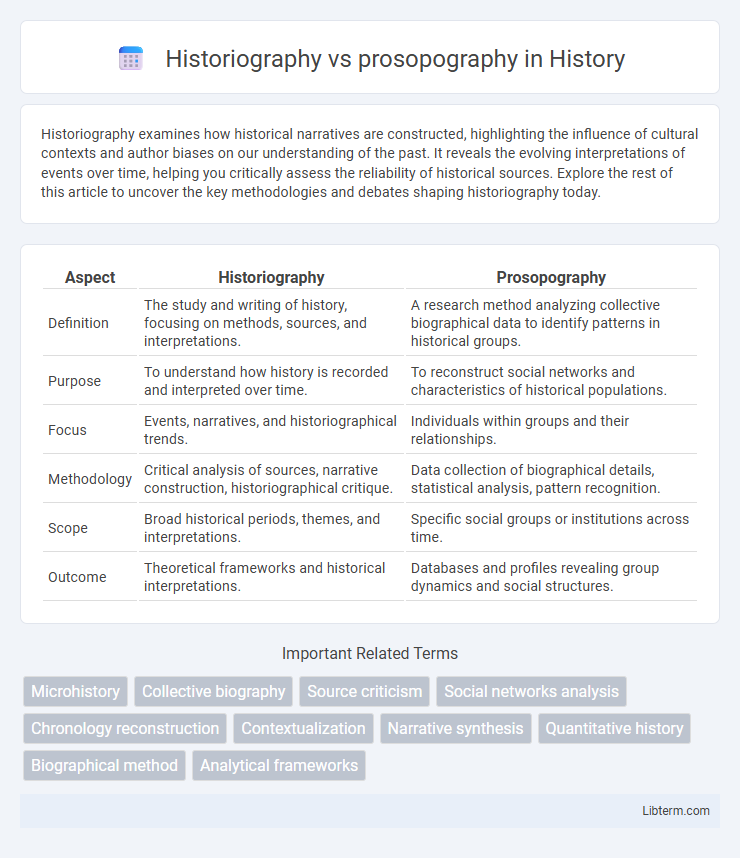Historiography examines how historical narratives are constructed, highlighting the influence of cultural contexts and author biases on our understanding of the past. It reveals the evolving interpretations of events over time, helping you critically assess the reliability of historical sources. Explore the rest of this article to uncover the key methodologies and debates shaping historiography today.
Table of Comparison
| Aspect | Historiography | Prosopography |
|---|---|---|
| Definition | The study and writing of history, focusing on methods, sources, and interpretations. | A research method analyzing collective biographical data to identify patterns in historical groups. |
| Purpose | To understand how history is recorded and interpreted over time. | To reconstruct social networks and characteristics of historical populations. |
| Focus | Events, narratives, and historiographical trends. | Individuals within groups and their relationships. |
| Methodology | Critical analysis of sources, narrative construction, historiographical critique. | Data collection of biographical details, statistical analysis, pattern recognition. |
| Scope | Broad historical periods, themes, and interpretations. | Specific social groups or institutions across time. |
| Outcome | Theoretical frameworks and historical interpretations. | Databases and profiles revealing group dynamics and social structures. |
Defining Historiography
Historiography is the study of how history is written, analyzing the methods, sources, and frameworks historians use to interpret past events, contrasting with prosopography, which focuses on collective biographies of historical figures. It examines the evolution of historical narratives and the influence of cultural, political, and ideological contexts on the recording of history. Understanding historiography is essential for evaluating the reliability and biases within historical accounts and for distinguishing between interpretation and factual evidence.
What Is Prosopography?
Prosopography is a research method in historical studies that systematically collects and analyzes biographical details of a group of individuals to identify patterns and social connections. Unlike traditional historiography, which focuses on narrative and interpretation of historical events, prosopography emphasizes quantitative data and relationships among people within specific contexts. This approach is invaluable for understanding social structures, political networks, and collective biographies in historical research.
Origins and Development of Historiography
Historiography, originating in ancient Greece with figures like Herodotus and Thucydides, developed as the systematic study and writing of history based on critical analysis of sources and narrative construction. Prosopography emerged later as a methodological tool within historical research, focusing on the collective study of individuals' biographies to identify patterns and social structures. The development of historiography laid the foundational frameworks and critical approaches that enabled prosopography to evolve as a specialized sub-discipline for understanding historical contexts through collective biographical data.
The Emergence of Prosopographical Approaches
Prosopography emerged in the 19th century as a methodological advancement within historiography, emphasizing collective biography to uncover patterns among historical groups rather than focusing on individual narratives. This approach systematically compiles data about the common characteristics of a historical population, enabling scholars to analyze social structures, networks, and relationships. By shifting attention from singular events to group dynamics, prosopography complements traditional historiographical techniques and enriches the understanding of historical contexts.
Key Differences Between Historiography and Prosopography
Historiography examines the methods and principles of writing history, emphasizing the analysis of sources, author biases, and historical narratives, while prosopography focuses on the collective study of biographical details of a specific group to identify patterns and social structures. The key difference lies in historiography's broad approach to interpreting historical events, whereas prosopography systematically compiles and analyzes data about individuals within a defined population. Prosopography utilizes databases and statistical techniques to reveal relationships and trends, contrasting with historiography's critical evaluation of historical texts and contexts.
Methodologies in Historiographical Research
Historiographical research employs critical analysis of primary and secondary sources to interpret historical events, emphasizing the evolution of historical narratives and the biases influencing them. Prosopography, a methodological subset, systematically collects and analyzes collective biographical data of groups to identify social patterns and relationships within historical contexts. This approach enhances historiographical studies by providing empirical evidence to support or challenge prevailing interpretations of historical phenomena.
Techniques and Tools for Prosopographical Studies
Prosopographical studies employ database management systems, network analysis software, and digital archives to systematically collect and analyze biographical data of historical groups. Techniques such as quantitative analysis, relational mapping, and data visualization enable researchers to uncover patterns in social structures, affiliations, and collective behaviors. These specialized tools distinguish prosopography from traditional historiography, which primarily relies on narrative sources and qualitative interpretations.
Applications in Historical Research
Historiography analyzes the development and interpretation of historical events through the study of sources, methodologies, and historians' perspectives, providing a comprehensive understanding of past narratives. Prosopography systematically examines collective biographical data of historical figures to identify patterns and social structures within specific groups, enhancing insights into historical communities and networks. Applications of historiography include critical source evaluation and the evolution of historical thought, while prosopography supports social history research, political analysis, and the reconstruction of historical demographics.
Advantages and Limitations of Each Approach
Historiography provides a broad analysis of historical events and contexts, enabling a comprehensive understanding of societal developments but often lacks detailed individual insights. Prosopography offers in-depth investigations into the collective characteristics of specific groups, revealing social networks and common traits, yet its scope can be limited by the availability and completeness of biographical data. Combining historiography's contextual breadth with prosopography's focused data enhances historical research by balancing macro perspectives with micro-level analysis.
Integrating Historiography and Prosopography in Modern Scholarship
Integrating historiography and prosopography in modern scholarship enhances the depth of historical analysis by combining narrative context with collective biographical data, allowing researchers to uncover social patterns and networks within specific historical periods. Historiographical methods provide critical evaluation of sources and interpret historical events, while prosopographical techniques systematically aggregate data about individuals to identify trends, relationships, and influences within groups. This interdisciplinary approach facilitates a more comprehensive understanding of past societies by synthesizing qualitative and quantitative data, thereby advancing research in fields such as social history, political history, and cultural studies.
Historiography Infographic

 libterm.com
libterm.com